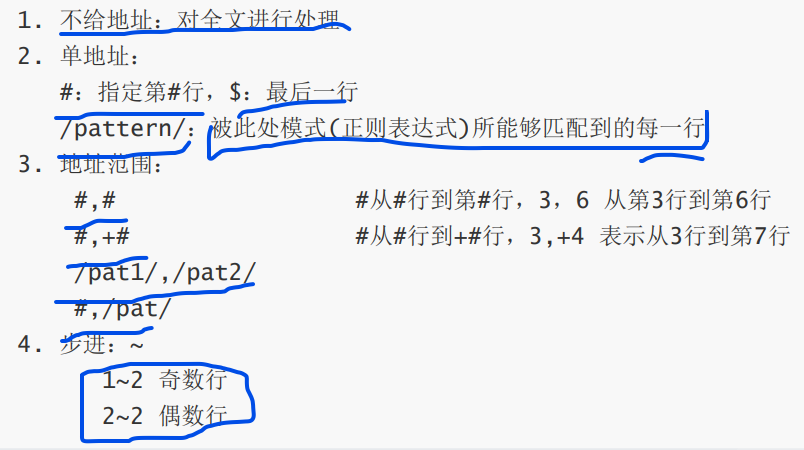grep
grep: Global search REgular expression and Print out the line
作用:文本搜索工具,根据用户指定的“模式”对目标文本逐行进行匹配检查;打印匹配到的行
模式:由正则表达式字符及文本字符所编写的过滤条件grep [OPTIONS] PATTERN [FILE...]
—color=auto 对匹配到的文本着色显示 -A # after, 后#行
-m # 匹配#次后停止 -B # before, 前#行
-v 显示不被pattern匹配到的行 -C # context, 前后各#行
-i 忽略字符大小写 -e 实现多个选项间的逻辑or关系,如:grep –e ‘cat ’ -e ‘dog’ file
-n 显示匹配的行号 -w 匹配整个单词
-c 统计匹配的行数 -E 使用ERE,相当于egrep
-o 仅显示匹配到的字符串 -F 不支持正则表达式,相当于fgre
-q 静默模式,不输出任何信息 -f file 根据模式文件处理
-r 递归目录,但不处理软链接
-R 递归目录,但处理软链接
[root@CentOS ~]$ grep root /etc/passwdoperator:x:11:0:operator:/root:/sbin/nologin[root@CentOS ~]$ grep '^root' /etc/passwdroot:x:0:0:root:/root:/bin/bash[root@CentOS ~]$ grep 'bash$' /etc/passwdroot:x:0:0:root:/root:/bin/bash[root@CentOS ~]$ alias grepalias grep='grep --color=auto'
[root@localhost ~]$ df |grep '^/dev/sd' (#查看分区利用率)/dev/sda2 104806400 5962048 98844352 6% //dev/sda5 52403200 398464 52004736 1% /data/dev/sda1 999320 192988 737520 21% /boot[root@localhost ~]$ df |grep '^/dev/sd' |tr -s ' ' '%' |cut -d% -f5 |sort -n |tail -n121[root@localhost ~]$ ifconfig |grep broadcastinet 192.168.50.137 netmask 255.255.255.0 broadcast 192.168.50.255[root@localhost ~]$ ss -nt (查看我的主机和其他机子的连接)State Recv-Q Send-Q Local Address:Port Peer Address:PortESTAB 0 52[root@localhost ~]$ ss -nt |grep ^ESTABESTAB 0 52 192.168.50.137:22 192.168.50.1:56051[root@localhost ~]$ ss -nt |grep ^ESTAB |tr -s ' ' ':' |cut -d: -f6 |sort |uniq -c |sort -nr |head -n1(#查看谁访问我最多)1 192.168.50.1
[root@localhost ~]$ grep '^[st]' /etc/passwdsync:x:5:0:sync:/sbin:/bin/synctss:x:59:59:Account used by the trousers package to sandbox the tcsd daemon:/dev/null:/sbin/nologin[root@localhost ~]$ grep -v '^[st]' /etc/passwdroot:x:0:0:root:/root:/bin/bashbin:x:1:1:bin:/bin:/sbin/nologin[root@CentOS ~]$ grep -v "^#" /etc/profile | grep -v '^$'[root@CentOS ~]$ grep -v '^#\|^$' /etc/profile[root@CentOS ~]$ grep -v '^\(#\|$\)' /etc/profile[root@CentOS ~]$ grep -Ev '^(#|$)' /etc/profile[root@CentOS ~]$ egrep -v '^(#|$)' /etc/profile
sed

sed 即 Stream EDitor,和 vi 不同,sed是行编辑器。
Sed是从文件或管道中读取一行,处理一行,输出一行;再读取一行,再处理一行,再输出一行,直到最后一行。
每当处理一行时,把当前处理的行存储在临时缓冲区中,称为模式空间(PatternSpace)。
接着用sed命令处理缓冲区中的内容,处理完成后,把缓冲区的内容送往屏幕。接着处理下一行,这样不断重复,直到文件末尾。
格式:sed [option]... 'script;script;...' inputfile...
-n 不输出模式空间内容到屏幕,即不自动打印 -f FILE 从指定文件中读取编辑脚本
-**e 多点编辑 -r, -E 使用扩展正则表达式
-i.bak 备份文件并原处编辑
script格式:**'地址命令'

[root@CentOS ~]$ sed '' (#支持管道输入)welcomwelcom[root@CentOS ~]$ sed '' /etc/issue (#不给地址对全文进行处理,默认输出模式空间的内容,同cat)zhuyuanyuan is beauful\SKernel \r on an \m[root@CentOS ~]$ sed 'p' /etc/issue (#打印全文)zhuyuanyuan is beaufulzhuyuanyuan is beauful\S\SKernel \r on an \mKernel \r on an \m[root@CentOS ~]$ sed -n '' /etc/issue (#不给地址对全文进行处理,不自动打印)[root@CentOS ~]$ sed -n 'p' /etc/issue (#不给地址对全文进行处理,打印{当前模式空间}的内容)zhuyuanyuan is beauful\SKernel \r on an \m[root@CentOS ~]$ sed -n '1p' passwd (#设置不自动打印文件内容,打印处理后的第一行)root:x:0:0:root:/root:/bin/bash[root@CentOS ~]$ sed -n '$p' passwd(#设置不自动打印文件内容,打印处理后的最后一行,同tail -n1)apache:x:48:48:Apache:/var/www:/sbin/nologin[root@CentOS ~]$ sed -rn 's@(r..t)@\1ER@gp' passwd(#设置不自动打印文件内容和使用正则表达式,未给地址、替换并显示替换成功的行)rootER:x:0:0:rootER:/rootER:/bin/bashoperator:x:11:0:operator:/rootER:/sbin/nologin
[root@CentOS ~]$ ifconfig ens33 |grep broadcast |tr -s ' ' : |cut -d: -f3[root@CentOS ~]$ ifconfig ens33 |grep -Eo '([0-9]{1,3}.){3}[0-9]{1,3}' |head -n1192.168.50.148[root@CentOS ~]$ ifconfig ens33 |sed -n '2p' (#用sed取ip地址)inet 192.168.50.148 netmask 255.255.255.0 broadcast 192.168.50.255
[root@localhost ~]$ df |grep '^/dev/sd' |tr -s ' ' '%' |cut -d% -f5 |sort -n |tail -n1[root@CentOS ~]$ df |sed -rn '/^\/dev\//p' (#用sed取分区利用率)/dev/mapper/centos-root 104806400 5318944 99487456 6% /

